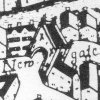The House that Alice Built
The house that Alice Chester built is long gone, but what a fascinating tale it still has to tell. It encapsulates the prosperity and piety that fuelled medieval Bristol.

Alice Chester's house can be seen on the right of the Angel Tavern in this drawing by Hugh O'Neill in 1810. At this time it was Samuel Hurley's shoe shop. Hurley had built a new shop front with bow windows and perhaps slotted in an extra floor over the shop. (Bristol Museums and Art Gallery).
Women in the Middle Ages had few chances to shine outside the home, while within it they deferred to husband or father. Married women could own nothing. So widows, though they might be grief-stricken, were in one way the most fortunate of women. They had their independence. As the wealthy widow of a merchant, Alice Chester ploughed her own furrow. (In records of the time the family name is given as Chestre or Chestour but here I use the modern spelling.)
Her husband Henry had been a draper. That conjures up a picture of a shopkeeper selling cloth. But Henry's interests spread much further than Bristol. He traded to Spain, Lisbon, Bordeaux and Brittany. He exported the cloth that was his major concern, and imported other goods. This overseas trade placed Henry in the mercantile elite who ran Bristol. He was Mayor of Bristol when he died on St Valentine's Day 1471.
Henry owned several properties by this time, but he probably spent his final days in the house he bought in 1463 towards the south end of the High Street. It lay in the parish of St Nicholas, but Henry remained devoted to the nearby Church of All Saints. He had his own well-placed pew there. His simple will left everything to Alice, except for pious benefactions. He wanted a chaplain to pray for his soul, but left his wife to arrange the details. Alice eventually gave a property in Broad Street to All Saints in return for prayers for Henry.
Meanwhile Alice had decided that the house in the High Street needed completely rebuilding. In 1472 she commissioned carpenter Stephen Morgan to make a new one. By great good fortune the building contract survives - a rare example from that period. Houses were not numbered in those days, but we know which one it was. The contract describes the house as beside the Bull, which later became the Angel Inn. The speed with which a house could be built is impressive. The contract was signed in November and the house was to be finished by the following March.
It is intriguing to see how the house weathered the centuries. Alice laid down exactly what she wanted. Morgan was to build a shop, a hall above it with an oriel window, a chamber above the hall with an oriel window, and another chamber above that. The timber-framing and oriel windows survived to be captured in several 19th-century drawings and photographs, though by then the ground floor had been refronted and apparently split into two storeys.

Alice Chester's merchant mark.
We can guess that this spanking new building was where Alice intended to live and carry on her husband's business. From 1473 until her death she traded in cloth, wine and other commodities with Ireland, Spain, Portugal and Flanders, often in her own ships.
Alice clearly prospered. She had money to lavish on the Church of All Saints. So generous was she that the church's dry record of benefactors bursts into praise of 'this blessed woman'. There is real warmth to the description of her many gifts and embellishments. Cloths, plate, a silver cross - the list goes on and on. Most notable were the elaborately carved fixtures that Alice paid for, including a new rood loft ornamented with figures of the Trinity and saints.
Merchants too had cause to thank Alice, for she donated the first crane to the Welsh Back. It made the loading and unloading of ships far safer and easier. And in a true Christian spirit, she gave thought to the needy. She arranged for gifts of bread to poor prisoners and lepers.
Her own family was not neglected. She lent large sums of money to one of her sons, who was Prior of Barlinch in Somerset. The other son was her heir and supported her benevolence. Since he died childless, his heirs eventually donated Alice's house in the High Street to All Saints Church.
It survived for centuries only to fall victim to Victorian improvements. The Corporation demolished the Angel Inn early in 1864 as part of a street-widening scheme. That left Alice's house insecure and it finally collapsed in July 1865.
























